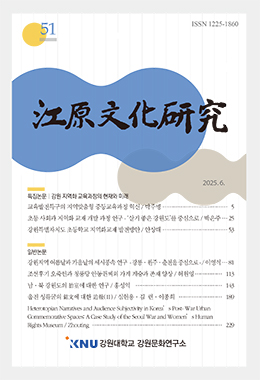본 연구은 1940년대 위안부 피해 경험과 현대 도시 삶을 잇는 헤테로토피아적 기념 공간으로서 ‘서울 전쟁과 여성인권 박물관(War and Women’s Human Rights Museum)’을 고찰한다. 푸코의 헤테로토피아 개념과 수용 이론, 심미적 임계치 개념, 네트워크 동원 이론을 동원하여, 내재된 공간 설계와 다중 매체 전시가 방문객을 수동적 관찰자에서 공감적 증인 및 사회적 행위자로 전환시키는 과정을 분석한다. 또한 현장에서 형성된 약속이 온·오프라인 연계를 통해 어떻게 지속적 행동 네트워크로 확산되는지를 추적한다. 연구 결과는 소규모기념 기관이 기억 보존과 지역사회 참여를 통합하는 실용적 모델을 제시함과 동시에, 도시 기념 공간 맥락에서 헤테로토피아 이론의 적용 범위를 확장함을 시사한다.
This paper investigates the Seoul War and Women’s Human Rights Museum as a heterotopian memorial space that bridges 1940s comfort-women atrocities and contemporary urban life. Drawing on Foucault’s heterotopia alongside reception theory, aesthetic-threshold concepts, and network mobilization theory, it examines how embedded spatial design and multimodal media transform visitors from passive observers into empathic witnesses and social actors. The study further traces how onsite commitments propagate via online-offline synergies into sustained action networks. Findings demonstrate a practical paradigm for small-scale memorial institutions to integrate memory preservation with community engagement and extend heterotopia theory to urban commemorative contexts.




